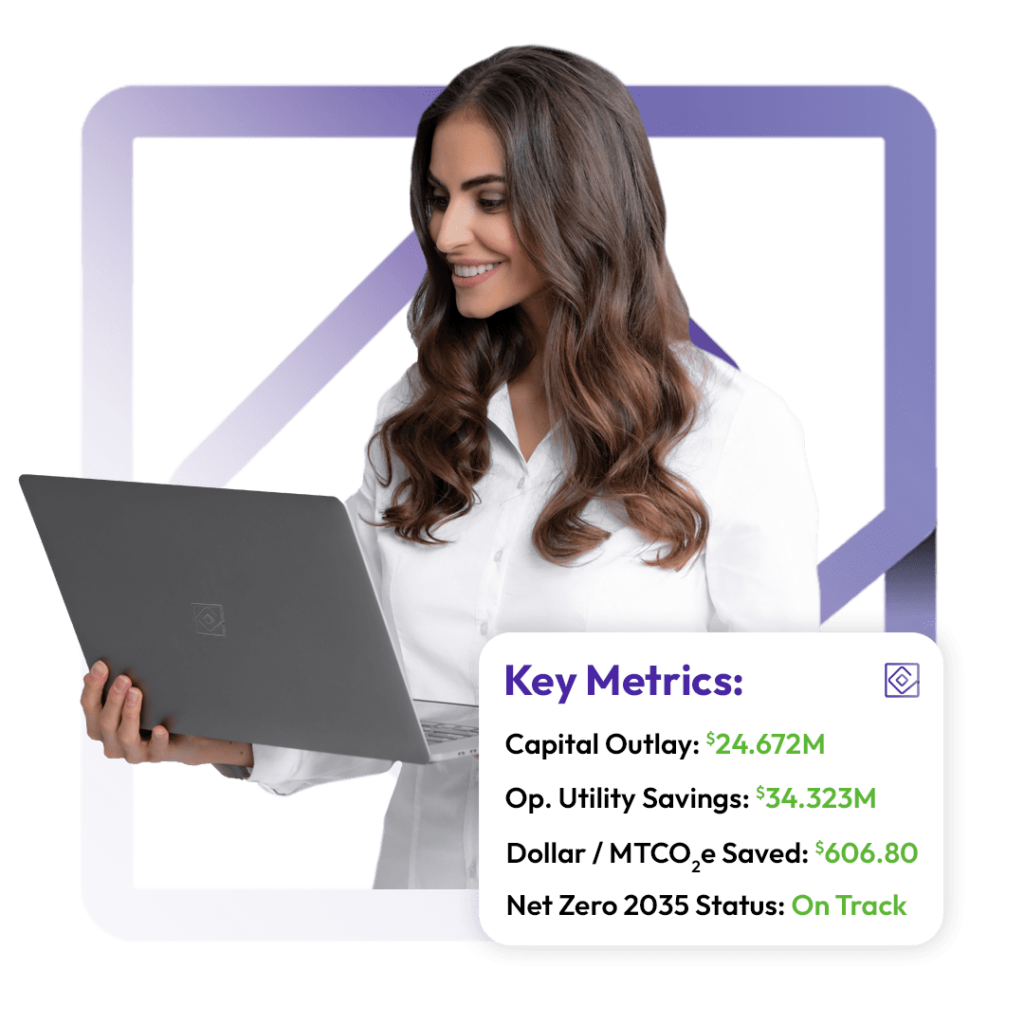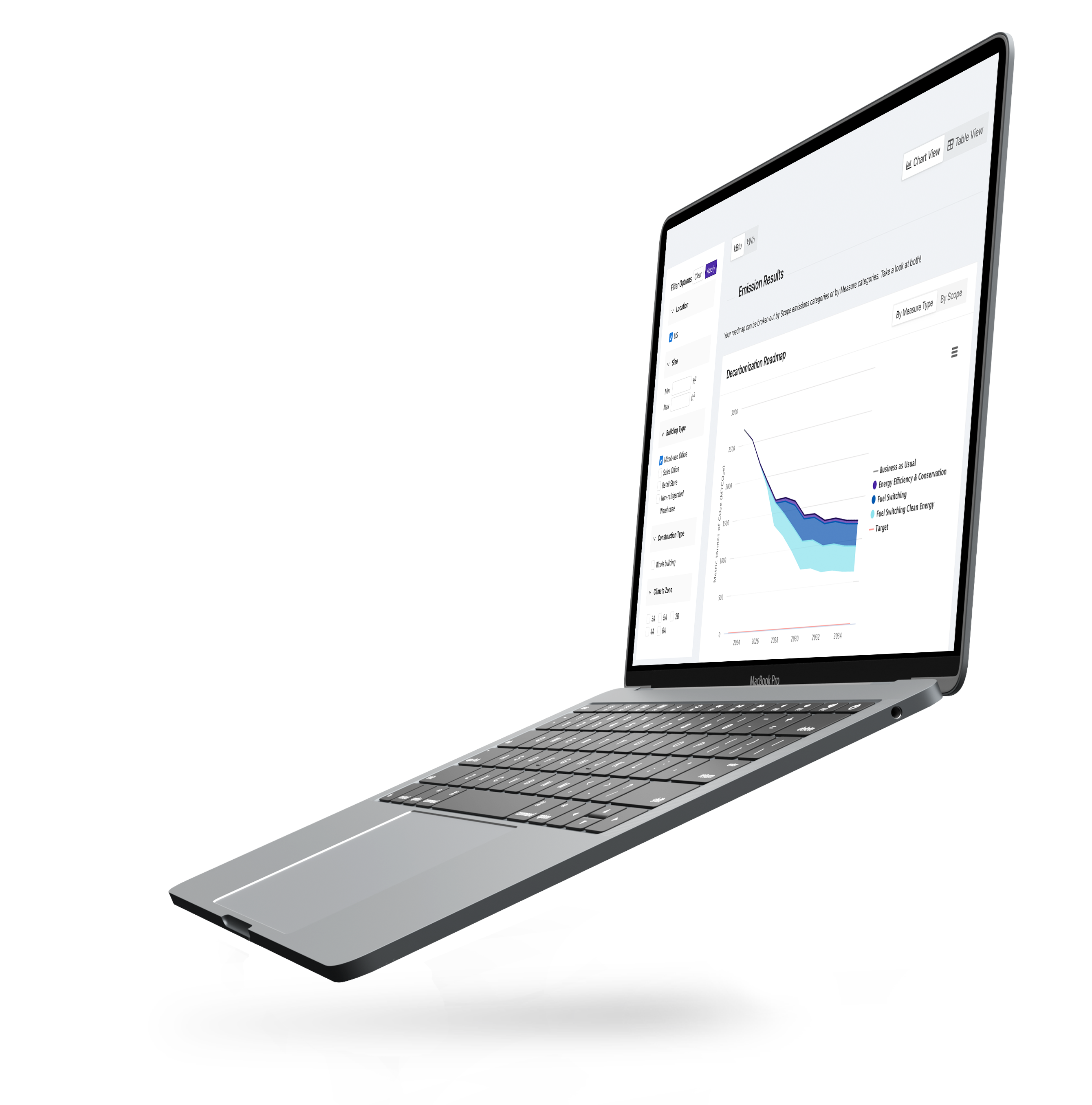FAQs
We answered your burning questions on Carbonsight
Look, we know it’s not quite 73 questions with Vogue, but we’ve been asked a lot of questions since the launch of Carbonsight.
We’ve summarized the main ones below. If there’s a question that you don’t see here, feel free to contact us.
General Questions
Carbonsight is an online decarbonization roadmapping tool for real estate portfolios. It allows you to create a building-by-building plan of action to hit Scope 1 and 2 emissions goals cost effectively portfolio-wide.
Carbonsight answers some very important questions.
- Decarbonization Roadmapping:
- What set of decarbonization measures will allow me to hit my Scope 1 and 2 carbon reduction goal?
- Capital Planning:
- What impact will these measures have on my capital budget and how much will it save me in utility costs?
- Risk Analysis:
- Is my plan future-proof to changing emission forecasts and utility costs? Carbonsight allows you to see how your roadmap performs under different scenarios to assess best and worst-case scenarios.
No, Carbonsight is a planning tool to hit GHG targets. However, Carbonsight is also being built to have the ability to track the progress of your decarbonization plan towards your goals using ongoing building energy data.
- Carbonsight is best for building owners who have set carbon targets and want an actionable plan of action to meet them.
- Carbonsight can be used at the campus-level, city-wide, across the U.S., and even internationally.
- Carbonsight can be used on any building typology and is perfect for universities, airports, school districts, cities, real estate firms, banks, and more.
Both, at the same time! We’ve found that building owners are going to energy engineering consultants and technical experts to perform this work, so Carbonsight is the tool consultants do the work in and owners use the results dashboard as the deliverable.
- Owners: Carbonsight’s deliverable – i.e. the roadmap & results dashboard – is meant for ESG leaders within companies that own buildings to make decisions on what decarbonization investments to move forward with.
- Consultants: Carbonsight is meant to be used by energy engineering & sustainability consultants or in-house ESG and energy teams with technical expertise to use in the analysis and delivery of roadmapping plans for building owners. These are the folks that are building the plan in Carbonsight.
Carbonsight can be used on small or large building portfolios. We’ve seen the most success in the range of of 10 – 150. Carbonsight is designed in such a way that you can assess a single building at a time or assess how measures can be implemented across dozens of buildings in a single dashboard.
Carbonsight is an annual license per portfolio. The cost is based on the number of properties in the portfolio.
Yes, you get a tailored training, onboarding, and ongoing support from our team.
We are open to discussing customizations to meet your unique needs. However, we provide a framework for users to create custom filters and tags to create unique dashboards based off their unique criteria.

Features
Yes, you can share access to the tool and the results dashboard with colleagues and other stakeholders.
- Carbonsight Essentials does not do energy modeling. It provides the skeleton for users who are already doing this technical work using spreadsheets and energy modeling to bring their data into an online interactive visualization deliverable.
- Carbonsight Pro enables users to do on-the-fly energy modeling by adjusting building performance characteristics.
Currently, Carbonsight is focused on Scope 1 and 2 operational carbon in buildings. However, we are working on adding more insights around Scope 3, so watch this space.
While we’ve found decarbonization planning is mainly focused on retrofitting existing buildings, Carbonsight can be used for portfolios with existing buildings, new acquisitions, or new construction.
We have location-specific electricity and gas rates and their price forecasts into the future. We also have location-specific grid emission factors and projections into how the grid will decarbonize in the future.
Yes! Speak to us about how we can do this for you.
You can apply energy efficiency and conservation measures, fuel switching measures, and renewable energy. We’re building capabilities for carbon offsets, RECs, and green power agreements.
No data? No worries! Carbonsight can fill data gaps in 2 ways:
- We can simulate baselines for a variety of building types and many different building codes by leveraging the Department of Energy’s reference building models
- Our Utility Link feature allows for direct transfer of data from your utility providers into our platform. Monthly utility bills for both electricity and natural gas are populated via API, saving a lot of time and hassle.
Knowing that this is new territory for so many ESG professionals, Carbonsight has been designed to ease the data collection, aggregation, and evaluation processes. There are four different methods for property data collection, upload, and storage in Carbonsight:
1) Manual entry & bulk upload
- For firms just starting the digital transition, direct input of data points or upload of excel based data related to baseline utility usage into Carbonsight is fully supported.
2) Simulated property baselines
- When you don’t have historical baseline energy data and are working on a budget, Carbonsight can simulate baselines for a variety of building types and many different building codes by leveraging the Department of Energy’s reference building models (https://www.energycodes.gov/prototype-building-models).
3) Energy Star Portfolio Manager integration
- Direct data transfer from Energy Star to Carbonsight takes the pain out of creating specific and up-to-date baselines for buildings portfolios. Furthermore, benchmarking your portfolio via Energy Star Scores allows for standardized EUI target setting and comparisons of your properties to similar buildings in your region. (https://www.energystar.gov/buildings/benchmark)
4) Carbonsight’s Utility Link functionality
- Our newest feature allows for direct transfer of data from your utility providers into our platform. Monthly utility bills for both electricity and natural gas are populated via API, and PDFs of your monthly energy bills are provided. More than just a basis for decarbonization roadmaps, Utility Link reduces the friction for energy management of all types.
- To start a plan you need to add building address, typology, size, and baseline energy use.
- Once your building data is in Carbonsight you can start building your decarbonization plan by creating measures and applying them to your buildings. This is where your technical specialist can add the EUI impact and upfront cost.
Yes, we automatically account for how the grid will change based on your location.
You can see both asset-level and portfolio-level results.
Security
We do not share any of your property data with other users nor do we use it to inform the analysis of other users. We may keep usage data to inform what features are most important to our users.
All data is encrypted at rest and we follow all the industry best practices to keep your data safe.
We have daily backups that are stored for at least one year.
Yes, simply file a request with your account manager and we’ll remove any and all data from your account or organization.
Request a Carbonsight demo today.
Speak with a Carbonsight expert to start saving time, money, and hassle creating a cost-effective decarbonization plan for your building portfolio.
You are also agreeing to receive information and offers relevant to Carbonsight’s service, and can opt-out at any time.
By submitting this form, you are agreeing to Carbonsight’s Privacy Policy and Terms of Service.


